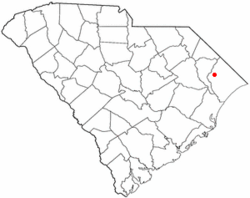Aynor, South Carolina facts for kids
Quick facts for kids
Aynor, South Carolina
|
||
|---|---|---|
|
||
| Nickname(s):
The Little Golden Town
|
||

Location in South Carolina
|
||
| Country | United States | |
| State | South Carolina | |
| County | Horry | |
| Area | ||
| • Total | 1.80 sq mi (4.67 km2) | |
| • Land | 1.80 sq mi (4.67 km2) | |
| • Water | 0.00 sq mi (0.00 km2) | |
| Elevation | 102 ft (31 m) | |
| Population
(2020)
|
||
| • Total | 974 | |
| • Density | 540.51/sq mi (208.73/km2) | |
| Demonym(s) | Aynorite | |
| Time zone | UTC-5 (EST) | |
| • Summer (DST) | UTC-4 (EDT) | |
| ZIP codes |
29511, 29544
|
|
| Area codes | 843, 854 | |
| FIPS code | 45-03430 | |
| GNIS feature ID | 1220269 | |
Aynor is a small town in Horry County, South Carolina, United States. It is located south of Galivants Ferry. In 2010, about 560 people lived there. By 2020, the population grew to 974. Aynor High School is known for being one of the best schools in Horry County and South Carolina.
Contents
Where is Aynor?
Aynor is in the northwestern part of Horry County. It is located along U.S. Route 501. This road goes about 15 miles (24 km) southeast to Conway, which is the main town of the county. It also goes about 18 miles (29 km) northwest to Marion. If you travel southeast on US 501, you can reach Myrtle Beach in about 29 miles (47 km).
The town covers a total area of about 1.8 square miles (4.8 square kilometers). All of this area is land.
Aynor's History
Aynor started as a farm called Eyknor's Farm in the mid-1800s. It was owned by Jacob Eyknor. Later, a railway station was built there, connecting it to the railroad from Conway. Because of the railway, the town officially became a town in 1913.
When it became a town, the people elected a mayor and town wardens. These wardens are like today's town council members. Gabriel Edwards (1849–1938) was the first mayor, elected in 1913. He was elected again in 1923. Aynor grew as a place where people produced things like turpentine (a liquid from pine trees), tobacco, and cotton. These were important crops that were sold.
People in Aynor
| Historical population | |||
|---|---|---|---|
| Census | Pop. | %± | |
| 1920 | 275 | — | |
| 1930 | 375 | 36.4% | |
| 1940 | 537 | 43.2% | |
| 1950 | 551 | 2.6% | |
| 1960 | 635 | 15.2% | |
| 1970 | 536 | −15.6% | |
| 1980 | 643 | 20.0% | |
| 1990 | 470 | −26.9% | |
| 2000 | 587 | 24.9% | |
| 2010 | 560 | −4.6% | |
| 2020 | 974 | 73.9% | |
| U.S. Decennial Census | |||
The United States Census helps us understand how many people live in a town and what groups they belong to.
2020 Census Information
In 2020, there were 974 people living in Aynor. These people lived in 298 households, and 232 of these were families.
| Race | Num. | Perc. |
|---|---|---|
| White (non-Hispanic) | 839 | 86.14% |
| Black or African American (non-Hispanic) | 64 | 6.57% |
| Native American | 7 | 0.72% |
| Asian | 5 | 0.51% |
| Other/Mixed | 31 | 3.18% |
| Hispanic or Latino | 28 | 2.87% |
Aynor's Economy
In 2013, a company called PTR Industries moved its business to the Cool Springs Business Park near Aynor. They moved from a state that had passed new laws about gun control. The company said they would hire more workers in Aynor. They planned to have 120 employees by 2017. This helped create jobs in the area.
Education in Aynor
Public schools in Aynor are managed by Horry County Schools. The school district runs three schools in Aynor:
- Aynor High School
- Aynor Middle School
- Aynor Elementary School
Aynor also has a public library. It is a part of the Horry County Memorial Library system.
See also
In Spanish: Aynor para niños


